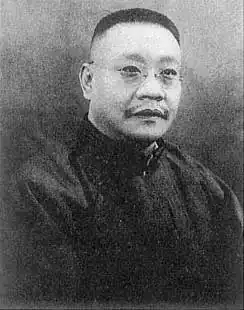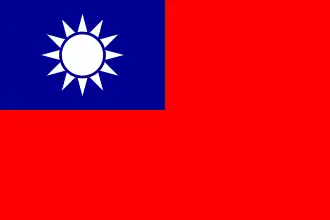Tan Yankai
Tan Yankai | |
|---|---|
譚延闓 | |
 | |
| Chairman of the National Government of China | |
| In office 7 February 1928 – 10 October 1928 | |
| Premier | Pan Fu |
| Preceded by | Zhang Zuolin (as Generallissimo of the Beiyang Government) |
| Succeeded by | Chiang Kai-shek |
| Premier of the Republic of China | |
| In office 25 October 1928 – 22 September 1930 | |
| President | Chiang Kai-shek |
| Preceded by | Pan Fu |
| Succeeded by | T. V. Soong |
| Personal details | |
| Born | 25 January 1880 Hangzhou, Zhejiang, Qing China |
| Died | 22 September 1930 (aged 50) Nanjing, Jiangsu, Republic of China |
| Resting place | Linggu Temple |
| Nationality | Republic of China |
| Political party | Kuomintang |
| Other political affiliations | Progressive Party |
| Parent |
|
| Education | jinshi degree in Imperial examination (1904) |
| Tan Yankai | |||||||||||
|---|---|---|---|---|---|---|---|---|---|---|---|
| Traditional Chinese | 譚延闓 | ||||||||||
| Simplified Chinese | 谭延闿 | ||||||||||
| |||||||||||
Tan Yankai ([tʰǎn jɛ̌n kʰàɪ]; Chinese: 譚延闓; 25 January 1880 – 22 September 1930) was a Chinese politician who briefly served as its head of state and premier.
Biography
Tan Yankai was born on 25 January 1880 in Hangzhou during the waning decades of the Qing dynasty. He was the son of the Qing minister Tan Zhonglin. A member of Liang Qichao's Constitutionalist Party, he campaigned for a parliament and restrained monarchy. As the party renamed itself the Progressive Party after the Xinhai Revolution, he was a major leader.
He left the Progressive Party and joined the Kuomintang and became military governor of Hunan.[1] He remained neutral during Sun Yat-sen's attempt to overthrow President Yuan Shikai in the 1913 Second Revolution, but Yuan removed him anyway. He returned to power after Yuan's death and led his province into resisting the Beiyang Army in the 1917 Constitional Protection Movement, which saved Sun's Guangdong base. After a brief attempt at spearheading federalism, his subordinates forced him to resign. When Chen Jiongming was driven out of Guangzhou, Tan was made home minister by Sun.
He served as Chairman of the National Government during the first half of the Northern Expedition and again during its conclusion. He was a member of Wang Jingwei's Wuhan Nationalist government and was the first internationally recognized head of state of the Nanjing-based Nationalist government. The United States was the first major power to give recognition on 1 October 1928, though they had already given de facto recognition back in July. After the Organic Law came to effect on the Double Ten Day, he was succeeded by Chiang Kai-shek. Tan then became premier, a post he would hold until he died in office.
Tan died of a cerebral hemorrhage on 25 September 1930 at the age of 50. T. V. Soong assumed his position as acting premier.[2]
Personal life
Tan is entombed in the grounds of the Linggu Temple, near the Sun Yat-sen Mausoleum in Nanjing.
His daughter,[3] Tan Hsiang, married Chen Cheng.
See also
References
- ^ "Hiller 09-053 : Tan Yankai tomb in Nankingby Hiller, Martin (Photographer), 1945 · Special Collections and Archives". library.missouri.edu. Retrieved 2024-11-07.
- ^ "谭延闿 - 《湖湘三千国民党将领》 - 抗日战争纪念网". m.krzzjn.com. Retrieved 2025-08-13.
- ^ Chan, Pedith Pui (2020-12-04). "The Discourse of Guohua in Wartime Shanghai". European Journal of East Asian Studies. 19 (2): 263–296. doi:10.1163/15700615-01902010. ISSN 1568-0584.
.svg.png)
